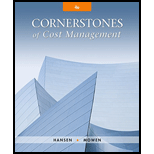
Concept explainers
Pratt Company produces two replacement parts for a popular line of Blu-ray disc players: Part A and Part B. Part A is made up of two components, one manufactured internally and one purchased from external suppliers. Part B is made up of three components, one manufactured internally and two purchased from suppliers. The company has two processes: fabrication and assembly. In fabrication, the internally produced components are made. Each component takes 20 minutes to produce. In assembly, it takes 30 minutes to assemble the components for Part A and 40 minutes to assemble the components for Part B. Pratt Company operates one shift per day. Each process employs 100 workers who each work eight hours per day.
Part A earns a unit contribution margin of $20, and Part B earns a unit contribution margin of $24 (calculated as the difference between revenue and the cost of materials and energy). Pratt can sell all that it produces of either part. There are no other constraints. Pratt can add a second shift of either process. Although a second shift would work eight hours, there is no mandate that it employ the same number of workers. The labor cost per hour for fabrication is $15, and the labor cost per hour for assembly is $12.
Required:
- 1. Identify the constraints facing Pratt, and graph them. How many binding constraints are possible? What is Pratt’s optimal product mix? What daily contribution margin is produced by this mix?
- 2. What is the drummer constraint? How much excess capacity does the other constraint have? Assume that a 1.5-day buffer inventory is needed to deal with any production interruptions. Describe the drum-buffer-rope concept using the Pratt data to illustrate the process.
- 3. Explain why the use of local labor efficiency measures will not work in Pratt’s TOC environment.
- 4. Suppose Pratt decides to elevate the binding constraint by adding a second shift of 50 workers (labor rates are the same as those of the first shift). Would elevation of Pratt’s binding constraint improve its system performance? Explain with supporting computations.
Want to see the full answer?
Check out a sample textbook solution
Chapter 20 Solutions
Cornerstones of Cost Management (Cornerstones Series)
 Cornerstones of Cost Management (Cornerstones Ser...AccountingISBN:9781305970663Author:Don R. Hansen, Maryanne M. MowenPublisher:Cengage Learning
Cornerstones of Cost Management (Cornerstones Ser...AccountingISBN:9781305970663Author:Don R. Hansen, Maryanne M. MowenPublisher:Cengage Learning Essentials of Business Analytics (MindTap Course ...StatisticsISBN:9781305627734Author:Jeffrey D. Camm, James J. Cochran, Michael J. Fry, Jeffrey W. Ohlmann, David R. AndersonPublisher:Cengage Learning
Essentials of Business Analytics (MindTap Course ...StatisticsISBN:9781305627734Author:Jeffrey D. Camm, James J. Cochran, Michael J. Fry, Jeffrey W. Ohlmann, David R. AndersonPublisher:Cengage Learning Managerial AccountingAccountingISBN:9781337912020Author:Carl Warren, Ph.d. Cma William B. TaylerPublisher:South-Western College Pub
Managerial AccountingAccountingISBN:9781337912020Author:Carl Warren, Ph.d. Cma William B. TaylerPublisher:South-Western College Pub


